The Parthenon is the eighth wonder of the world!? Part two: wealth of Parphenon.
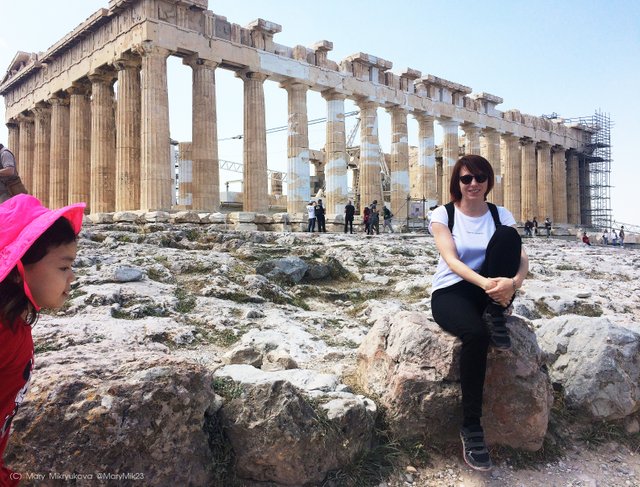
No, this photo is not a secret treasure of Parthenon, which I promised to tell you in this post. This is me on the right in the photo ))) and I can't do your photo on the background of the Parthenon so that other people don't disturb me ))) Tourists everywhere! and among them this sweet girl, whom I called the "red cap";) In this regard, here is another valuable advice: come to inspect the Parthenon to the very opening of the complex, it will not be so hot and not so many spectators. The working time of the complex varies depending on the season, so check it on the official website.
This is the second part of the post about the greatest temple of Ancient Greece-Parthenon. If you are interested to know how old the Parthenon is, why it stands as a fleet of ships and why it is called a symbol of the unification of the country, be sure to read the first part of my story.
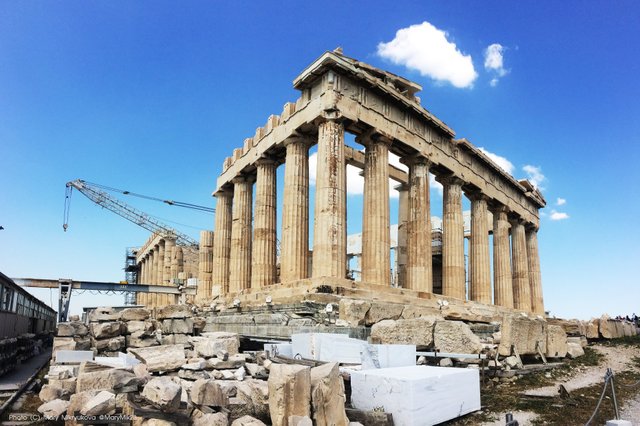
Search a woman
It is believed that the Parthenon - a kind of "packaging", a protective structure for the majestic statue of the goddess Athena, who was inside. The statue seemed enormous thanks to the second row of columns that ran along the inner wall of the Parthenon. Athena also stood on the background of five columns, located at the wall opposite the entrance to the temple. All these verticals visually increased the already large size of the statue.
The author of the main sculpture was Phidias. Its the basis was a solid wood: cedar, or cypress.. The body, the skin of Athena, represented the ivory. And all the apparel was made of removable gold plates (this technology was offered by Pericles, to protect against possible charges of theft of precious metal). To the wooden base of the sculpture is not cracked, she needed humidification. For this, a small pool was built inside the temple, about 10 centimeters deep. Due to the reflection of the statue on the surface of the water, the author received another unusual visual effect.
The statue made you believe in the greatness of the deity and worship it. In her right hand, Athena held the winged Nike. And leaned an outstretched hand on the very first in the history of architecture Corinthian column - thin, with the capital, decorated with plant elements and rolls spiral shape. It is interesting that the images of the statue of Athena that have reached us are different and not always the same column. Therefore, this theory can be considered only an assumption. The statue of Athena became fatal for Phidias. In the left hand of the goddess was a huge shield. There is a legend that on it the sculptor portrayed himself and Pericles, for which Phidias was severely punished.
Historical values of the Parthenon
Once in four years in Athens, there were celebrations in honor of the main patroness of the city. The Panathenaic procession at night with torches carried gifts from the Agora to the temple of the Acropolis. Including - luxurious "clothes" for the statue. On the altar, near the Parthenon, bulls were killed. With the first rays of the sun the doors of the temple opened and the procession could observe the statue of Athena in all its grandeur. After the religious ceremony, the Panatheneya Games began: athletes, musicians, theatrical performances. All the gifts to Athena formed into the treasury of the Parthenon - the second, smaller in size room of the temple, the entrance to which was on the west side. And the Panathenaic procession was depicted on the bas-relief of the internal frieze, part of which was preserved and is now exhibited in the nearby Acropolis museum, but most fragments are in the British Museum of London.
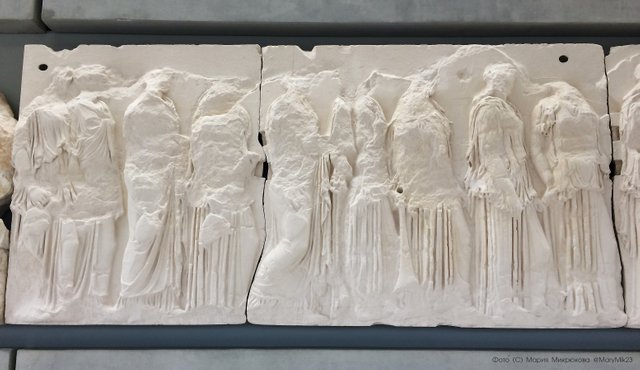
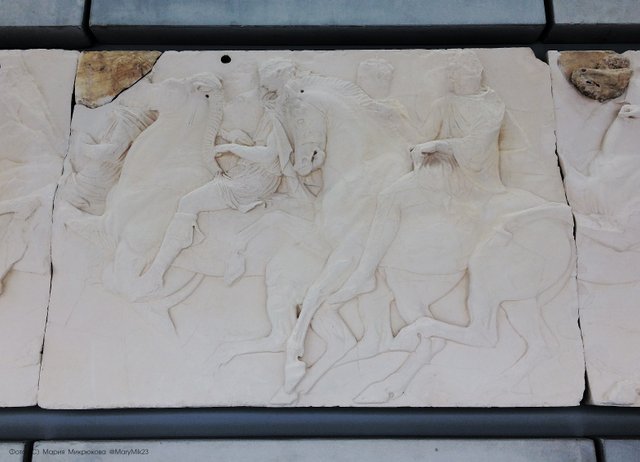
Phidias abundantly decorated the entire external surface of the building with reliefs and sculpture. The eastern pediment, located above the main entrance, represented the scene of the birth of Athena from the head of Zeus. Western - a competition between Athena and Poseidon. Partially preserved are only a few sculptures of the pediments, their copies are in the Acropolis Museum, and the originals are also in Britain. According to the preserved fragment, it is possible to assess how detailed the sculptures were. Despite the fact that a person could only observe them from a distance from the bottom, even the back surface of the statues was worked out, in fact it was believed that they were created for the gods. The compositions of the pediments are recreated according to the drawings of the 17th century and their reconstruction can also be seen in the museum.

Click on the picture and you can see the picture in a big size

Click on the picture and you can see the picture in a big size
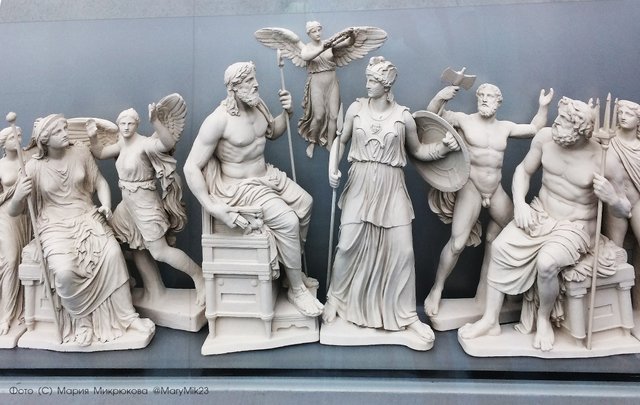
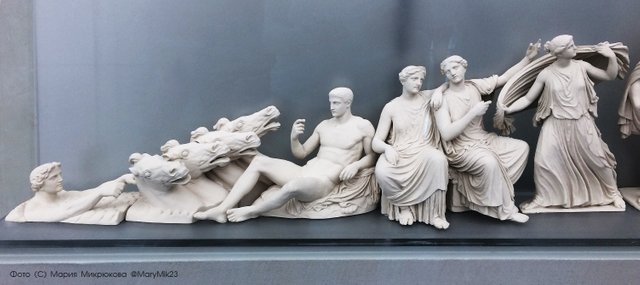
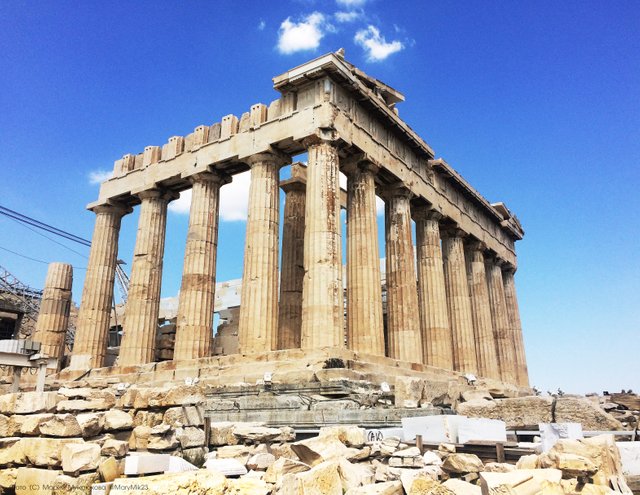
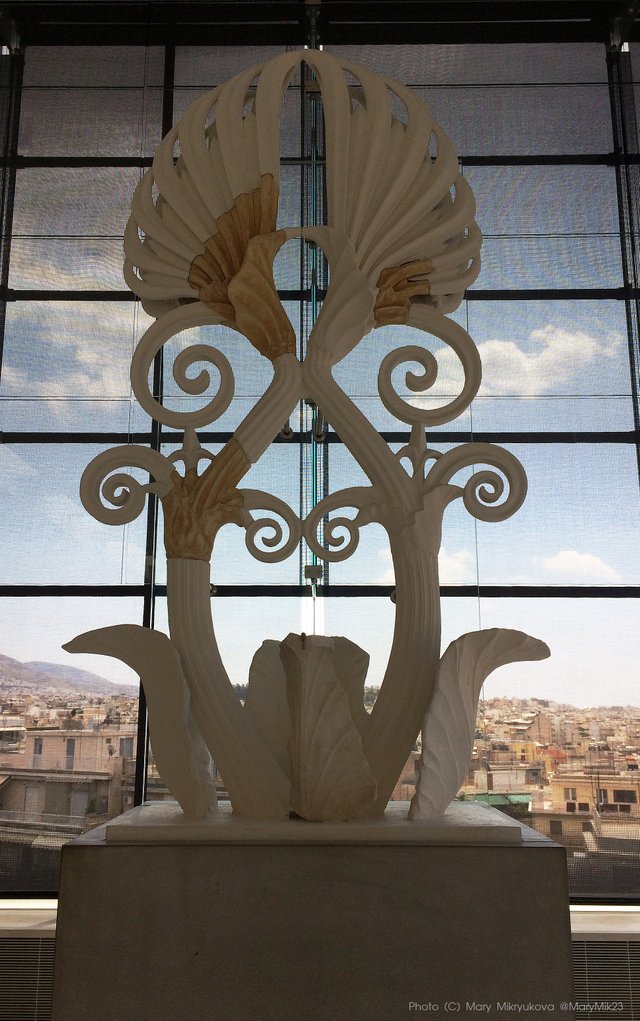
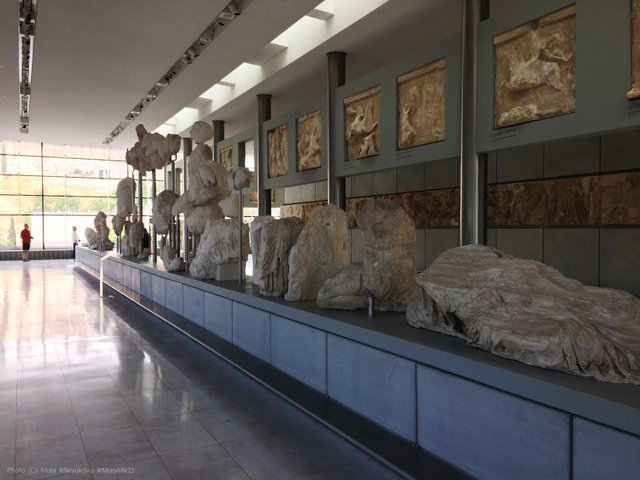
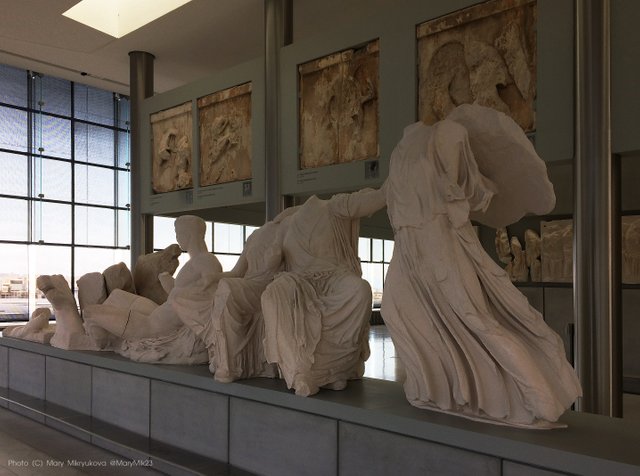
Today on the Parthenon there are only copies of the sculpture of the horse's head in the corners of the pediment. To the left are the frisky dawn horses from the chariot of Helios, and in the right corner the head of the tired horse of the goddess of the night Nyuks. Further on the Parthenon we can see a part of the figure of Kefal (sitting with his back to Olympus), who watches over Helios emerging from the ocean.
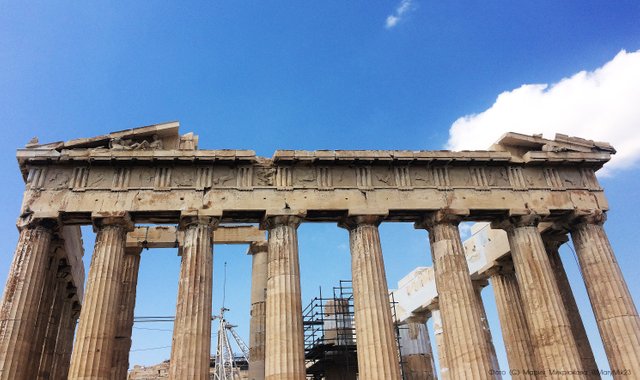
Click on the picture and you can see the picture in a big size
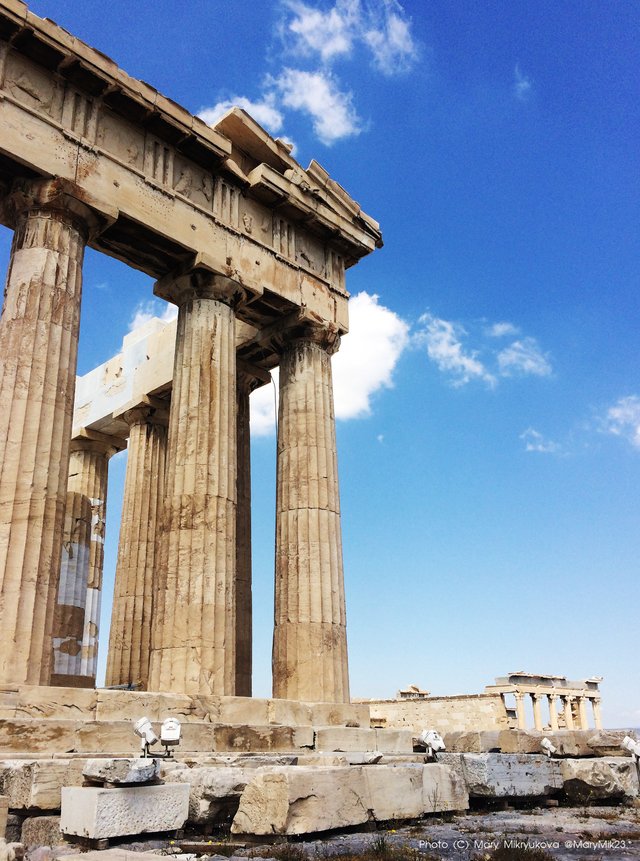
Traditional Doric order complemented the metopes - relief plates over the columns of the temple. The metopes of the eastern facade depicted the battle of the gods and titans, the metopes from the southern side of the Parthenon - the opposition of the Greeks and Centaurs, and from the West - the struggle against the Amazons. The northern part completed the relief ensemble with scenes of the Trojan War.
All the reliefs were made of marble, but some parts of the harnesses of horses and uniforms of warriors were made of metal. The depth of the relief is about 10 centimeters. But the effect of volume was further enhanced by color. Yes, the Parthenon was colored! The Greeks used mineral dyes, quite bright, the color is still partially preserved on some reliefs. The paint was absorbed in the stone, while retaining the texture of the marble, allowing him to play in the sun.
The Parthenon's tragedy and the renaissance from the ashes
The last decoration of the Parthenon acquired under Alexander the Great, who placed on the eastern facade shields of Persian soldiers, presented as gifts to Athena. After the death of this great conqueror, the plunder of the Parthenon began. In the third century BC, the tyrant Leohar removes all the gold from the statue of Athena. The following rulers do not stand on ceremony with the temple, setting the statues in their honor. In 267, during the attack of one of the barbarian tribes, the temple was looted and burnt. Marble can not stand the heat and began to deteriorate, the wooden ceilings and the statue burned out completely. Since the third century of our era the Parthenon has been rebuilt several times, including the Orthodox church, and only its inner part was involved, and the outer colonnade remained without a roof and continued to collapse. In 1458, the Turks conquered Greece. The Orthodox bell tower was completed to the minaret, and the temple was turned into a mosque. The Sultan's harem was placed in the Erechtheion, and the faces of the beautiful Greek caryatids were destroyed. The apotheosis of this barbarism was the explosion of the powder storehouse in the Parthenon in 1687, which almost completely destroyed this architectural masterpiece.
In 1801, Lord Elgin brought to Britain most of the surviving reliefs and statues of the Parthenon under the pretext of preserving cultural values. In order to reduce the weight of the marble, parts of the sculptures were sawed and thrown in the ruined ruins. It is now difficult to say whether the plundering of the Parthenon by the British was so justified. Today Greece, despite numerous requests, can not return these values home.
In the modern museum of the Acropolis, which is located literally at the foot of the complex, there are reconstructions and a few original fragments of sculpture. I recommend visiting this museum. This modern building was built as a sarcophagus to preserve the excavations of the ancient Greek city, which can be seen through the glass floor. On the upper floors of the museum are reconstructed fragments of friezes and other parts of the temple, you can mentally transfer them to the Parthenon, which is perfectly visible from the windows.
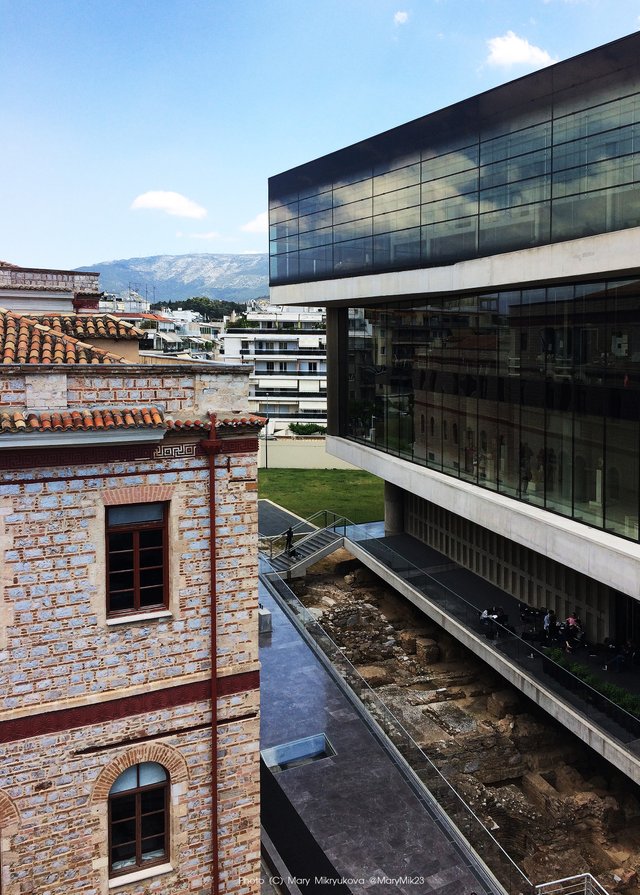
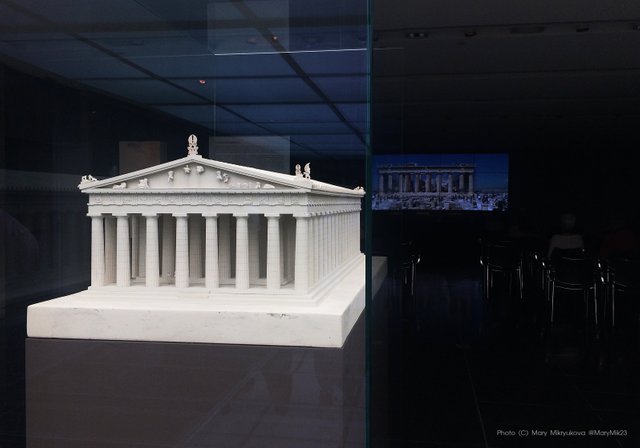
In one of the halls of the museum I saw a film in which the destruction of the Parthenon is shown. People put up stairs and ruthlessly knock down reliefs, saw marble. I could not stop crying when I saw this barbarism with my own eyes.
In 1834, when Athens was already part of independent Greece, the Parthenon was declared a monument to the ancient heritage. It began its reconstruction, but the knowledge and technology of that time only caused more damage. Only in 1975, UNESCO began to offer new ways of saving the Parthenon. Restoration continues today and will last for several decades. I believe that 70,000 pieces of marble scattered around the Parthenon someday will form a single puzzle and we will see the eighth wonder of the world in its original form!
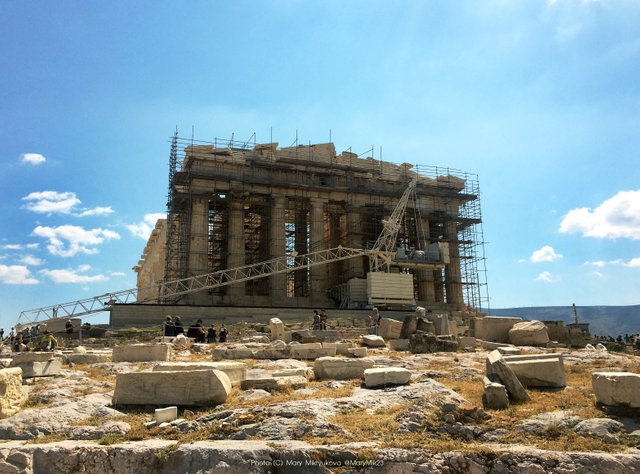
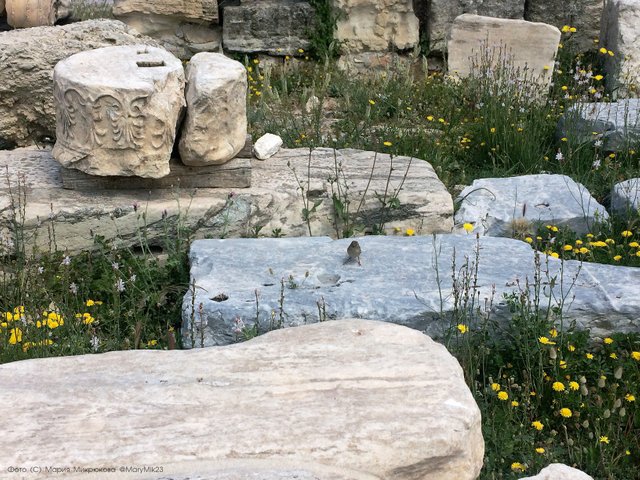
Dear friends, I thank you for your attention. I have some more interesting stories about Greece, which I will publish in the next posts.
Text, photos and good mood - ©Copyright @marymik23 (19.06.2018)
RU
Нет, это не тайное сокровище Парфенона, о котором я буду рассказывать в этом посте. Это я никак не могу сделать собственную фотографию на его фоне ))) Туристы повсюду! и среди них эта милая девочка, которую я назвала "красная шапочка" ;) В связи с этим, вот еще один мой ценный совет: приезжайте осматривать Парфенон к самому открытию комплекса, будет не жарко и не так много зрителей. Время работы комплекса меняется в зависимости от сезона, поэтому уточните его на официальном сайте.
Это вторая часть поста о величайшем храме древней Греции - Парфеноне. Если вам интересно узнать сколько лет Парфенону, почему он стоит целого флота и за что его называют символом объединения страны, обязательно прочтите первую часть моего рассказа.
Ищите женщину
Считается, что Парфенон - это своеобразная "упаковка", защитное сооружение для величественной статуи богини Афины, которая находилась внутри. Статуя казалась огромной благодаря второму ряду колонн, который проходил по внутренней стене Парфенона. Афина так же стояла на фоне пяти колонн, расположенных у стены, противоположной входу в храм. Все эти вертикали зрительно увеличивали и без того большой размер статуи.
Автором главной скульптуры был Фидий. Её основой служили твёрдые породы дерева: кедр, либо кипарис. Тело, кожу Афины изображала слоновая кость. А всё одеяние было выполнено из съемных пластин золота (эту технологию предложил Перикл, для защиты от возможных обвинений в воровстве драгоценного металла). Чтобы деревянная основа скульптуры не потрескалась, ей было необходимо увлажнение. Для этого внутри храма был сооружен небольшой бассейн, глубиной примерно 10 сантиметров. За счет отражения статуи на поверхности воды, автор получил еще один необычный зрительный эффект.
Статуя заставляла верить в величие божества и поклоняться ему. В правой руке Афина держала крылатую Нику. А опиралась вытянутая рука на ту самую первую в историю архитектуры коринфскую колонну - тонкую, с капителью, украшенной растительными элементами и завитками спиралеобразной формы. Интересно, что изображения статуи Афины, дошедшие до нас различны и не везде есть та самая колонна. Поэтому, эту теорию можно считать лишь предположением. Статуя Афины стала роковой для Фидия. В левой руке богини был огромный щит. Существует легенда, что на нём скульптор изобразил себя и Перикла, за что Фидий был жестоко наказан.
Исторические ценности Парфенона
Раз в четыре года в Афинах проходили праздники в честь главной покровительницы города. Панафинейская процессия ночью с факелами несла дары от Агоры к храму Акрополя. В том числе - роскошные "одежды" для статуи. На жертвеннике рядом с Парфеноном убивали быков. С первыми лучами солнца двери храма открывались и процессия могла наблюдать статую Афины во всём её величии. После религиозной церемонии начинались Панафинейские игры: состязания атлетов, музыкантов, театральные представления. Все дары Афине складывались в сокровищницу Парфенона - второе, меньшее по размеру помещение храма, вход в которое был с западной стороны. А Пинафинейская процессия была изображена на барельефе внутреннего фриза, часть которого сохранилась и сейчас экспонируется в расположенном поблизости музее Акрополя, но большинство фрагментов находится в Британском, в Лондоне.
Фидий обильно украсил всю внешнюю поверхность здания рельефами и скульптурой. Восточный фронтон, расположенный над главным входом, представлял сцену рождения Афины из головы Зевса. Западный - состязание Афины и Посейдона. Частично сохранилось лишь несколько скульптур фронтонов, их копии находятся в музее Акрополя, а оригиналы так же в Британии. По сохранившимся фрагментом можно оценить насколько детализированы были скульптуры. Несмотря на то, что человек мог наблюдать их только издалека снизу, была проработана даже задняя поверхность статуй, ведь считалось, что они создавались для богов. Композиции фронтонов воссозданы по рисункам 17 века и их реконструкцию так же можно увидеть в музее. Сегодня на Парфеноне установлены только копии скульптуры головы коня в углах фронтона. Слева резвые рассветные кони из колесницы Гелиоса, а в правом углу голова уставшей лошади богини ночи Нюкс. Далее на Парфеноне мы можем увидеть часть фигуры Кефала (сидящего спиной к Олимпу), который наблюдает за Гелиосом, появляющимся из океана.
Традиционный дорический ордер дополняли метопы - рельефные плиты над колоннами храма. Метопы восточного фасада изображали битву богов и титанов, метопы с южной стороны Парфенона - противостояние греков и кентавров, а с западной - борьбу с амазонками. Северная часть завершала рельефный ансамбль сценами Троянской войны.
Все рельефы были выполнены из мрамора, но некоторые части сбруи коней и обмундирования воинов создавались из металла. Глубина рельефа - около 10 сантиметров. Но эффект объема усиливался еще и за счет цвета. Да, Парфенон был цветным! Греки использовали минеральные красители, довольно яркие, цвет до сих пор частично сохранился на некоторых рельефах. Краска впитывалась в камень, при этом, сохраняла фактуру мрамора, позволяя ему играть на солнце.
Трагедия Парфенона и возрождение из пепла
Последние украшения Парфенон приобрел при Александре Македонском, который разместил на восточном фасаде щиты персидских воинов, преподнесенные в качестве даров Афине. После смерти этого великого завоевателя, началось разграбление Парфенона. В третьем веке до нашей эры тиран Леохар снимает всё золото со статуи Афины. Следующие правители не церемонятся с храмом, устанавливая статуи в свою честь. В 267 году во время нападения одного из варварских племен храм был разграблен и сожжен. Мрамор не выносит высокой температуры и начал разрушаться, деревянные перекрытия и статуя выгорели полностью. С третьего века нашей эры Парфенон неоднократно перестраивался, в том числе под православный храм, причем была задействована только его внутренняя часть, а внешняя колоннада осталась без крыши и продолжала разрушаться. В 1458 году турки завоевали Грецию. Православная колокольня была достроена до минарета, а храм превращен в мечеть. В Эрехтейоне был размещен султанский гарем, а лица прекрасных греческих кариатид - уничтожены. Апофеозом этого варварства стал взрыв порохового склада в Парфеноне в 1687 году, который практически полностью уничтожил этот архитектурный шедевр.
В 1801 году лорд Элгин вывез в Британию большую часть сохранившихся рельефов и статуй Парфенона под предлогом сохранения культурных ценностей. Для того, чтобы уменьшить вес мрамора, части скульптур опиливались и были брошены у растерзанных руин. Сейчас сложно сказать был ли вывоз скульптур и рельефов британцами столь оправдан. Сегодня Греция, несмотря на многочисленные запросы, не может вернуть эти ценности на родину.
В современном музее Акрополя, который расположен буквально у подножия комплекса, экспонируются реконструкции и немногочисленные оригинальные фрагменты скульптуры. Я рекомендую посетить этот музей. Это современное сооружение построено как саркофаг для сохранения раскопок древнегреческого города, который можно наблюдать сквозь стеклянный пол. На верхних этажах музея экспонируются фрагменты фризов и других частей храма, вы можете мысленно перенести их на Парфенон, который отлично виден из окон. В одном из залов музея я посмотрела фильм, в котором показано разрушение Парфенона. Люди подставляют лестницы, забираются по ним, и безжалостно сбивают рельефы, пилят мрамор. Я не смогла сдержать слёз, когда увидела это варварство своими глазами.
Скульптуры классные!!!
Великие греческие скульпторы, да... Даже в этом состоянии производит впечатление. А представляете, как это всё выглядело в момент создания?
Да уж, красиво...
Hi @marymik23!
Your post was upvoted by utopian.io in cooperation with steemstem - supporting knowledge, innovation and technological advancement on the Steem Blockchain.
Contribute to Open Source with utopian.io
Learn how to contribute on our website and join the new open source economy.
Want to chat? Join the Utopian Community on Discord https://discord.gg/h52nFrV
Thank you @utopian-io, ! I really needed your support! I wish development and success to your project!
fascinating :)
I would really like to see the statue of Athena, it's a pity that this will never happen ...
I would also like to see the statue. And the thing is that we can rebuild all these ancient monuments. But every archeologist I've talked to is strictly against the idea of recreating them ...
Have you spoken with the archaeologist? it is very interesting! what else did he tell you?
I also think that it is impossible to restore these monuments in this place. Because they can die. But if they build a new Parthenon - a copy of the old one in another place, I'll gladly see it.
In the museum on video, I saw very modern technologies for the restoration of Erechtheion sculptures. It was awesome...
I have discussed the idea of restoring the monuments in their original form on site. They were all strongly opposed. Almost a blasphemy. And I don't remember anyone giving any other reasoning other than "it's completely wrong".
Technically it can be done.
And why is it now being restored? The missing pieces of marble are replaced by a lighter one, this looks strange ...
I don't know ...
This is a wonderful post. I wish I could feature you in #pifc, but, rules are rules - rep 50 or under ...
But, you are invited to use #ccc for Guaranteed 👍 Daily Income 💵 and Payout 💸 for Newbies 🐟 🐜 🐛 in #ccc 👣 and Follow 👣 the Honor Code 🏅 - the Creed (Conditions and Limits Inside)
All the best!
Thanks for the advice, and what posts are usually posted on the tag #ccc ? )
I want to help newbies to help each other and of course, they will need sponsors and role models.
The #ccc tag is free to use by anyone and stands for Curation Circle Creed - the honor code listed in the post on Guaranteed Daily Income.
So, using it will hopefully attract more honorable people than not.
You can join any day for any post and not for others as you wish.
I am helping to assure a payout for newbies that need my upvote and help. And using #ccc helps us find each other.
I'll try to use this tag in one of the following posts, thanks!
Great article! Whe I see your photos I can't belive its photos from your smartphone. Amasing.
This is exactly my smartphone) Thank you, @amikphoto!
Congratulations, Your Post Has Been Added To The Steemit Worldmap!
Author link: http://steemitworldmap.com?author=marymik23
Post link: http://steemitworldmap.com?post=the-parthenon-is-the-eighth-wonder-of-the-world-part-two-wealth-of-parphenon
Want to have your post on the map too?
wow awesome post. I love seeing pictures of the artifact
Hello! Thank you ) Yes, it's very interesting to look at the ancient buildings and sculptures.
How are you? Did they draw new portraits?
Дочь в августе поедет в Грецию
На острова, или на материк?
Что-от она, кажется про Крит говорила.
Кажется в Херсониссос поедут.
Материк мне кажется более насыщенным для впечатлений, хотя на островах я не была )
Впечатляет ! Это без техники , без подъёмных кранов. Руками строили!
Да, строили с применением простейших механизмов. Чтобы поднять мраморный брусок, его привязывали веревкой за специальные выступы, которые вытёсывали еще при добыче камня. Когда стена, или другая конструкция, были готовы, эти "установочные наросты" сбивали и полировали мрамор до гладкого состояния...
Спасибо, буду знать. Хорошего дня.